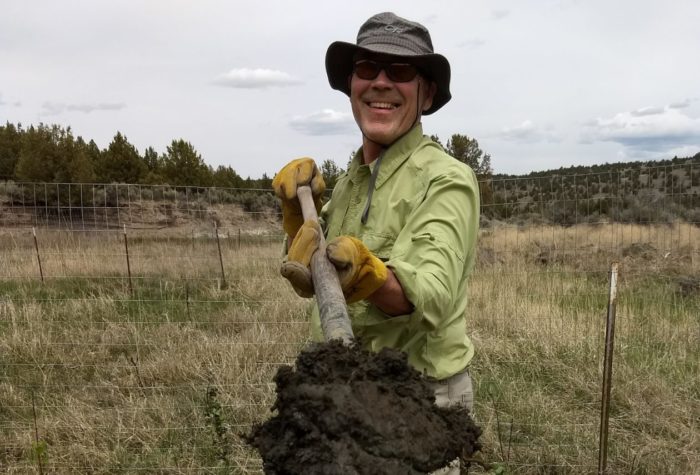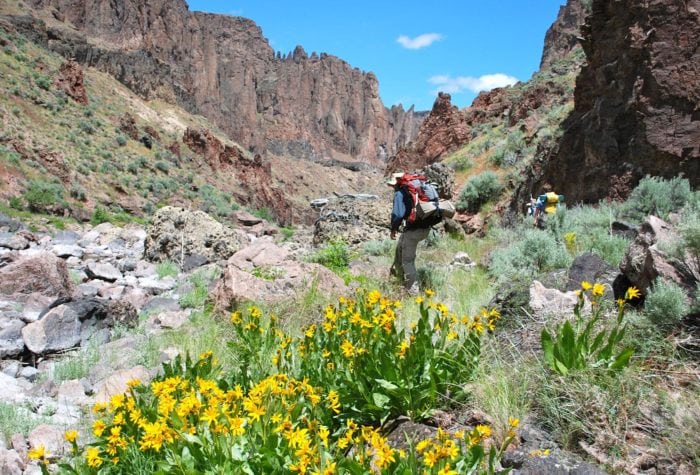Denny Jones Ranch Restoration #2
Organizer: Beth Macinko
Start Date: 9/21/2020
End Date: 9/24/2020
Region: Malheur River Basin
Difficulty Rating: 3 out of 5
Maximum Group Size: 15 participants
About the place
The Burns Paiute Tribe acquired the Denny Jones Ranch near Juntura, Oregon in 2000. This property consists of 6,385 acres of meadow, wetland, and sagebrush steppe habitats along the Malheur River. The Tribe is managing the property to improve critical habitat for fish and wildlife populations, control and eradicate weed populations, improve water quality and preserve cultural resources for tribal members.
The Burns Paiute Natural Resource Department’s preliminary goals for the property are:
- restore the riparian vegetative corridor
- restore fish passage and in-stream habitat
- convert degraded rangeland to productive wildlife habitat
- improve irrigation efficiency and meadowland hay productivity and
- develop and preserve ranch infrastructure.
ONDA has agreed to partner with the Tribe to accomplish important restoration work that supports their objectives over the next four years.
About the stewardship work
For this trip, volunteers will be spending two days working to remove young, expanding juniper from the ranch.
Western Juniper has been expanding throughout much of its range. The rapid increase has many land managers concerned about the health of the sagebrush-grassland habitat because juniper can displace many of the shrubs and grasses that provide forage to wildlife and at-risk species such as sage-grouse. Junipers also cause problems for many watersheds because they require large amounts of water as compared to other shrubs or grasses.
Volunteers will work with ONDA and Burns Paiute staff to remove juniper from critical sage-grouse habitat, using handsaws and loppers to target small diameter trees. It can be difficult, hot, scratchy, and challenging, but it feels good to look back at the end of the day and see a landscape turned back into sagebrush and bunchgrass.
We typically head to the work site at 8 a.m. and stop work by 4 p.m. in order to leave time in the afternoon to clean-up, relax, and cook a well-deserved dinner. No previous juniper removal experience is needed to attend this trip. ONDA and Burns Paiute staff will provide all instruction and necessary tools to do the job. All that is required is a love of the high desert, a big smile and a willingness to learn.
Trip Timeline
- Monday, September 21, 5 p.m. We will meet at our campsite on the ranch. Volunteers will be able to drive right into camp.
- Tuesday, September 22: After breakfast, we will carpool to the worksite to begin our first day of juniper removal. Volunteers should plan to be out all day and be prepared for a full day of walking, kneeling and doing physical work in weather that could range from cold and wet to hot and dry.
- Wednesday, September 23: After breakfast, we will carpool to the worksite to begin our second day of juniper removal. Volunteers should plan to be out all day and be prepared for a full day of walking, kneeling and doing physical work in weather that could range from cold and wet to hot and dry.
- Thursday, September 24: After breakfast the group will be free to head home or spend some additional time exploring the expansive property that we will be working on.
Camp
We will be car camping in an open meadow near a ranch house with access to running water and bathroom facilities. Volunteers should plan to bring all necessary camping equipment to spend three nights outside in what could be cool and wet weather this time of year.
Difficulty
The work will require walking approximately two miles each day, kneeling down and digging holes for plants, and carrying a daypack with food, water and ample clothing to stay warm and dry in variable conditions.
Participant responsibilities
Participants are responsible for their own food and camping gear as well as transportation to and from the trip (don’t forget your camp chair!). ONDA will bring water, but it is a good idea to supplement our supply with a few gallons from home. In the event of sunny and hot weather, please bring up to four liters of water capacity for the day, and consider an electrolyte replacement drink or mix to help you stay hydrated. Sturdy off-trail ankle-high boots, long pants, a long sleeve shirt (a lightweight sun shirt is a great option), and eye protection are required for this trip (sunglasses or prescription eyeglasses are suitable eye protection). Participants should be prepared to be away from camp all day and bring a daypack for lunch, snacks, and water.
Gear Provided
ONDA will provide tools for the work, work gloves and sunscreen. ONDA will bring some group camping equipment (shade tent, tables for cooking, and wash bins for kitchen cleanup), potable water and expert leadership.
Registration
An ONDA registration application and medical form are required for this trip. Check the box next to each trip you would like to attend. You only need to fill this form out once per year.
Apply Now
What happens next?
You will receive a confirmation email within 10 working days of submitting your form. The confirmation email will provide information regarding which trips you are on the “participant list” for, and which trips are full, and therefore you have been placed on the “waitlist.”
Six weeks before the start of the trip, the trip leader will send out an RSVP to make sure everyone is still able to participate. Based on RSVPs, open spaces will be backfilled with people from the waitlist.
Three weeks before the trip start date, registered and confirmed participants will receive driving instructions, maps, carpooling options, and additional information in an email sent by the trip leader
If you have any questions in the meantime, please don’t hesitate to contact the trip leader.
Your Trip Leader
This trip will be led by ONDA's Stewardship Coordinator, Beth Macinko. For questions about the trip call (541) 330-2638 ext. 312 or email bmacinko@onda.org.
Meet BethSage Sustainers Membership
Live your values with a monthly gift in support of Oregon’s desert public lands, waterways, and wildlife. Sage Sustainers members propel critical conservation efforts alongside a dynamic community of advocates. […]
Read More
